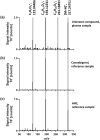Insights into the human metabolism of hexahydrocannabinol by non-targeted liquid chromatography-high-resolution tandem mass spectrometry
- PMID: 38687640
- PMCID: PMC11165647
- DOI: 10.1093/jat/bkae022
Insights into the human metabolism of hexahydrocannabinol by non-targeted liquid chromatography-high-resolution tandem mass spectrometry
Abstract
Hexahydrocannabinol (HHC), 6,6,9-trimethyl-3-pentyl-6a,7,8,9,10,10a-hexahydrobenzo[c]chromen-1-ol, is a semi-synthetic cannabinoid that has presented challenges to analytical laboratories due to its emergence and spread in the drug market. The lack of information on human pharmacokinetics hinders the development and application of presumptive and confirmatory tests for reliably detecting HHC consumption. To address this knowledge gap, we report the analytical results obtained from systematic forensic toxicological analysis of body-fluid samples collected from three individuals suspected of drug-impaired driving after HHC consumption. Urine and plasma samples were analyzed using non-targeted liquid chromatography-high-resolution tandem mass spectrometry. The results provided evidence that HHC undergoes biotransformation reactions similar to other well-characterized cannabinoids, such as ∆9-tetrahydrocannabinol or cannabidiol. Notably, HHC itself was only detectable in plasma samples, not in urine samples. The observed Phase I reactions involved oxidation of C11 and the pentyl side chain, leading to corresponding hydroxylated and carboxylic acid species. Additionally, extensive glucuronidation of HHC and its Phase I metabolites was evident.
© The Author(s) 2024. Published by Oxford University Press.
Figures





Similar articles
-
Human metabolism of the semi-synthetic cannabinoids hexahydrocannabinol, hexahydrocannabiphorol and their acetates using hepatocytes and urine samples.Drug Test Anal. 2025 Mar;17(3):372-386. doi: 10.1002/dta.3740. Epub 2024 May 28. Drug Test Anal. 2025. PMID: 38804224 Free PMC article.
-
Quantification of (9R)- and (9S)-hexahydrocannabinol (HHC) via GC-MS in serum/plasma samples from drivers suspected of cannabis consumption and immunological detection of HHC and related substances in serum, urine, and saliva.Drug Test Anal. 2024 May;16(5):489-497. doi: 10.1002/dta.3570. Epub 2023 Aug 31. Drug Test Anal. 2024. PMID: 37652872
-
Detection of 11-nor-9-carboxy-hexahydrocannabinol (HHC-COOH) as metabolite of both hexahydrocannabinol (HHC) and Δ9-tetrahydrocannabinol (Δ9-THC) in routine forensic samples.J Pharm Biomed Anal. 2025 Aug 15;261:116833. doi: 10.1016/j.jpba.2025.116833. Epub 2025 Mar 22. J Pharm Biomed Anal. 2025. PMID: 40139040
-
Hexahydrocannabinol and closely related semi-synthetic cannabinoids: A comprehensive review.Drug Test Anal. 2024 Feb;16(2):127-161. doi: 10.1002/dta.3519. Epub 2023 Jun 2. Drug Test Anal. 2024. PMID: 37269160 Review.
-
Analysis of cannabinoids in conventional and alternative biological matrices by liquid chromatography: Applications and challenges.J Chromatogr A. 2021 Aug 16;1651:462277. doi: 10.1016/j.chroma.2021.462277. Epub 2021 May 24. J Chromatogr A. 2021. PMID: 34091369 Review.
Cited by
-
Cross-reactivity of the epimers of 11-nor-9-carboxy-hexahydrocannabinol, metabolites of hexahydrocannabinol, with panel tests for urinary Δ9-tetrahydrocannabinol metabolites.Forensic Toxicol. 2025 Jul;43(2):365-369. doi: 10.1007/s11419-025-00717-4. Epub 2025 Mar 28. Forensic Toxicol. 2025. PMID: 40153118
References
-
- The European Monitoring Centre for Drugs and Drug Addiction (EMCDDA) . (2023) Hexahydrocannabinol (HHC) and Related Substances. https://www.emcdda.europa.eu/publications/technical-reports/hhc-and-rela... (accessed May 15, 2023).
MeSH terms
Substances
LinkOut - more resources
Full Text Sources
Miscellaneous

